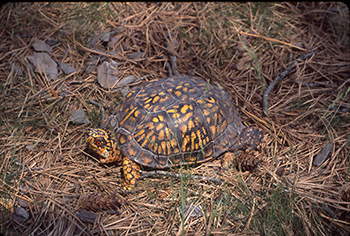Home → Fish & Wildlife → Wildlife → Species Information → Reptiles & Amphibians → Eastern Box Turtle
Eastern Box Turtle
Terrapene carolina
On this page:

Photo: Jonathan Mays
Distinguishing Characteristics

Photo: Trevor Persons
- Medium-sized, carapace (upper part of shell) approximately 4 to 8 inches in length
- High, dome-shaped carapace is dark brown or black, with yellow, orange, or olive markings
- Limbs and head are dark gray with yellow or orange blotches
- Males have red eyes
- Double-hinged plastron (bottom part of shell) allows turtle to fully seal itself within its shell when threatened
Status and Distribution in Maine
- After decades of survey effort, no viable eastern box turtle populations have been found in Maine and it is believed that any sporadically encountered individuals were imported and released pets. With no modern or historical confirmation of a native box turtle population in Maine, MDIFW recommended removal of the species from the Maine Endangered Species list, which was then enacted by the state legislature in 2023.
- Rare; possibly no native populations; all records, including in southern region, may represent escaped or liberated pet turtles
- Southern region only
Habitat
- Terrestrial, prefers areas of sandy soils
- Open woods, meadows, brushy fields, cleared powerline right-of-ways
Diet
- Omnivorous, eats invertebrates as well as vegetation, primarily fruit, fungi, and leaves and stems
Seasonal Changes
- Hibernates underground in burrows or beneath leaf litter
Natural History Notes
- Although no native populations occur in the state, individual box turtles are reported on occasion from many parts of the state and are capable of overwintering in Maine. Eastern box turtle sightings may be reported online through the Maine Reptile and Amphibian Atlas portal.
- In mating, male mounts the shell of the female and position his body to be nearly vertical on top of her—males have been known to fall backwards onto their shell and die that way, unable to right themselves
- Mating occurs May through October, with egg laying in June and July. Females may store sperm for several years before laying fertilized eggs